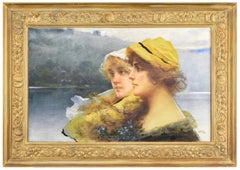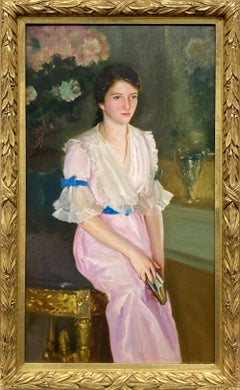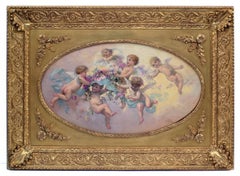Adriano Goby Art
to
1
1
1
Overall Width
to
Overall Height
to
1
1
1
1
2
2
1
1
1
1
2
2
2
2
2
10,138
2,779
1,375
1,369
2
1
Artist: Adriano Goby
Beautiful Italian Art Nouveau Portrait of two women
By Adriano Goby
Located in New York, NY
Beautiful Italian Art Nouveau style portrait of two women by Adriano Goby. Signed low-right.
Category
Early 20th Century Art Nouveau Adriano Goby Art
Materials
Canvas, Oil
$3,750 Sale Price
25% Off
Adriano Goby Oil Portrait of a Romantic Lady
By Adriano Goby
Located in New York, NY
A large female figural portrait of a romantic era woman in canary yellow silk dress and ornate structured bonnet with violet bows. Posed within a garden next to a large bush of white...
Category
19th Century Adriano Goby Art
Materials
Canvas, Oil
Related Items
“North African Man, c. 1916-21” by Caleb Arnold Slade, American Portrait Oil
By Caleb Arnold Slade
Located in Yardley, PA
“North African Man, c. 1916-21” by Caleb Arnold Slade (American, 1882-1961)
Inspired by Slade’s travels in Algeria and Tunisia, this remarkable portrait depicts a young man standing...
Category
Early 20th Century American Impressionist Adriano Goby Art
Materials
Canvas, Oil
$9,500
H 47.5 in W 40.25 in D 1.5 in
"Reading in the Study" Impressionist Portrait Oil Painting Woman in Pink Dress
Located in New York, NY
An Early 20th Century elegant portrait oil painting by Gordon Stevenson depicting a pensive young woman seated in a serene, indoor setting wearing a l...
Category
1910s American Impressionist Adriano Goby Art
Materials
Oil, Canvas
Gordon Stevenson"Reading in the Study" Impressionist Portrait Oil Painting Woman in Pink Dress, 1917
$35,000
H 60 in W 36 in D 3 in
Portrait of Noblewoman - Oil on Canvas by Anonymous Master Early 20th Century
Located in Roma, IT
Beautiful circular oil on canvas representing the portrait of a Noblewoman dressed in Art Nouveau Style.
It includes a contemporary black wooden frame.
Very good conditions.
Category
Early 20th Century Art Nouveau Adriano Goby Art
Materials
Oil
$3,002
H 10.24 in Dm 10.24 in
"Founding Father" George Washington Impressionistic Oil Painting on Canvas
By Cindy Shaoul
Located in New York, NY
This painting depicts an impressionistic and abstract portrait of George Washington. The thick brush strokes and fun marks create an atmosphere reminiscent of the impressionists from...
Category
2010s American Impressionist Adriano Goby Art
Materials
Canvas, Oil
$1,600
H 25 in W 21 in D 2 in
1916 Danish Interior Genre Painting Conversation w Reverend Scene Framed Oil
Located in Stockholm, SE
Painting is signed for acknowledged artist Niels Holbak 1884-1954, who educated at the Art Academy in Finland 1909-10 and was taught at the Art Academy in Copenhagen from 1912-1914 a...
Category
1910s Realist Adriano Goby Art
Materials
Canvas, Wood, Oil
$670
H 27.3 in W 24.2 in D 1 in
1830's French Romantic Period Large Oil Painting Christ on the Cross
By Eugène Delacroix
Located in Cirencester, Gloucestershire
The Crucifixion
French School, circa 1830's
circle of Eugene Delacroix (1798-1863)
oil on canvas, unframed
canvas: 37.5 x 22.5 inches
provenance: private collection, northern France
...
Category
Early 19th Century Romantic Adriano Goby Art
Materials
Oil, Canvas
$2,120 Sale Price
30% Off
H 37.5 in W 22.5 in
Robert Kenneth White "Sanctuary in Feathers" Large Figurative Oil Painting
Located in Miami, FL
ROBERT KENNETH WHITE – "SANCTUARY IN FEATHERS"
⚜ Oil on Canvas ⚜ Hand Signed Lower Right ⚜ Frameless Display
HUMANITY AND HARMONY
“Sanctuary in Feathers” captures a poignant moment ...
Category
2010s Realist Adriano Goby Art
Materials
Canvas, Oil
Robert Kenneth WhiteRobert Kenneth White "Sanctuary in Feathers" Large Figurative Oil Painting, 2018
$7,000
H 45 in W 38 in D 1 in
Portrait of Civil War Union Sailor titled "Soldier"
Located in Fredericksburg, VA
Rick Reeves’ Soldier is a striking historical portrait that reflects the artist’s mastery of military realism and dedication to historical accuracy. Painted in alkyd oils, the work c...
Category
21st Century and Contemporary Contemporary Adriano Goby Art
Materials
Canvas, Oil
Empress II - Original Sally K Figurative Portrait Artwork on Canvas
By Sally K
Located in Los Angeles, CA
Lebanese American artist Sally K.'s captivating floral portraits are both mesmerizing and empowering. Her pop-realistic paintings are inspired by strong, feminine women, celebrating the individuality and inherent strength of the female experience. Each painting features endless floral arrangements that frame the mysterious visages of beautiful women, creating a stunning celebration of floral abstraction and wild, fanciful coloration. Lavish in application and luxurious in composition, Sally K.'s work is inspired by pop art, culture, and fashion, resulting in a powerful, visually stunning artwork that captures the essence of femininity.
This monochrome 47-inch high by 38-inch wide painting is created with acrylic paint with green paint accents on canvas. It is stretched, wired, and ready to hang. This floral figurative artwork is signed by the artist on the front of the artwork. The sides are a continuation of the painting and it is stretched, wired, and ready to hang. Free local Los Angeles area delivery. Convenient U.S. and global shipping is available. A certificate of authenticity issued by the art gallery is included.
Sally K. is an Ohio-born artist of Lebanese heritage who spent her formative years in Saudi Arabia before attending high school and college in Beirut. She graduated with distinction from the Lebanese American University of Beirut, earning a BA in Fine Arts. After moving back to the United States in 2013, Sally K. and her family eventually relocated once more to Qatar in 2019. Sally's multicultural background and diverse experiences inform her artistic vision, resulting in a unique style that blends Middle Eastern and Western influences.
Sally K's work is a celebration of femininity, strength, and individuality, reflecting her own journey as a woman and artist. Her captivating portraits of contemporary women are a masterful blend of abstract expressionism and portrait painting, featuring vibrant blooms that create a dreamlike aura around her powerful subjects. Her paintings not only capture the beauty of women but also their confidence and strength, conveying a powerful femininity that inspires and empowers. With alluring, flirtatious, and demure features, Sally's portraits radiate sensuality, independence, and confidence - the very qualities that define strong women.
Sally's portraits are intensely personal, as each woman she paints is an extension of her own feelings, thoughts, and experiences. Through her work, she captures the qualities that captivate her in other women - the qualities she admires and strives to gain for herself. Her paintings are a celebration of the complexities and strengths of women, conveyed through a masterful use of color, texture, and composition.
Sally K's use of occlusion, a technique where she covers the eyes of the figures, adds a layer of depth and complexity to her pop-realistic artworks. This technique creates a sense of mystery and intrigue that invites the viewer to contemplate the inner life of the subjects, while the lack of eye contact encourages a deeper emotional connection with the painting. As a result, viewers are able to engage with the piece on a more personal and intimate level, experiencing a range of emotions and reactions that are unique to them. The sense of mystery and depth allows for a more immersive and personalized experience, making Sally K's works truly captivating and thought-provoking.
Sally draws inspiration from photography, pop culture, and fashion as well as artists ranging from the pop art of Willem de Kooning and Jackson Pollock to the gilded florals and figures of Gustav Klimt. Her highly regarded paintings have been featured in group and solo shows in Beirut, Dubai, Italy, Switzerland, and the USA. They have been collected worldwide. Notable collectors include Jesse McCartney and Kelly Clarkson.
REPRESENTATION
Artspace Warehouse, Los Angeles, USA
EXHIBITIONS
2024 Affordable Art Fair, New York, NY
2024 Artspace Warehouse, Los Angeles, CA
2024 Affordable Art Fair, Austin, TX
2023 Artspace Warehouse, Los Angeles, CA
2022 “Identity with a Chance of Imperfection”, Artspace Warehouse, Los Angeles, CA
2022 “Saturate Euphoria”, Artspace Warehouse, Los Angeles, CA
2021 Affordable Art Fair New York, NY
2021 “Splatters of Life”, Artspace Warehouse, Los Angeles, CA
2020 LA Art Show, CA
2020 Art Palm Springs, CA
2019 Affordable Art Fair Hong Kong
2019 Affordable Art Fair New York
2019 Artspace Warehouse, Los Angeles, CA
2018 "Colored Whipped Cream," Artspace Warehouse, Los Angeles, CA
2018 Threshold Art Gallery, Los Angeles, CA
2018 484 North Gallery, Laguna Beach
2013 Beirut Art Beat
2009 Lebanese Artists Association
2009 Gallery Surface Libre
2008 Lebanese Painters Exhibition
2007 Café De Prague Hamra
2007 Cream Saifi Village
2007 Matignion Gallery, Horsh Tabet
2007 Drops Batroun (permanent)
2007 Cloud Nine Jemaizeh (permanent)
2007 Tribecca Monnot
2006 Art Lounge, Beirut, Lebanon
2006 MILK Jemaizeh (permanent)
2006 Gauche Caviar Jemaizeh (permanent)
2006 ESCWA Riad El Solh
2006 Tapas Jemaizeh (permanent)
2006 Zinc Achrafieh
2006 Blush Monot
2006 The Basement Jemaizeh
2005 Solo Gallery Show, Art Lounge, Beirut
2005 Zinc Achrafieh
2005 Tribecca Monot Café
2004 Paul Guiragossian...
Category
21st Century and Contemporary Art Nouveau Adriano Goby Art
Materials
Canvas, Mixed Media, Acrylic
$3,700
H 47 in W 38 in
Important Victorian portrait of Alexander Smith
Located in New York, NY
Important Victorian painting depicting Alexander Smith. It has a fantastic frame and is in excellent condition. Written Alex Smith (...) on the letter.
Category
Mid-19th Century Victorian Adriano Goby Art
Materials
Canvas, Oil
Red - Original Sally K Figurative Artwork
By Sally K
Located in Los Angeles, CA
Gazing at Lebanese American artist Sally K's floral portrait is consuming and empowering. Inspired by strong, feminine women, she creates pop-realistic paintin...
Category
21st Century and Contemporary Art Nouveau Adriano Goby Art
Materials
Canvas, Mixed Media, Acrylic, Board
Film Still #4 (portrait, western movie, cowboy, Hat, shadow, monochrome art)
By Rudolf Kosow
Located in Quebec, Quebec
With eyes obscured and hat lowered, this figure is both iconic and unknowable—a faceless cowboy adrift in a pale, open void. Kosow distills the visual codes of Americana and cinemati...
Category
2010s American Realist Adriano Goby Art
Materials
Canvas, Oil
$1,560
H 11.82 in W 11.82 in D 0.99 in
Previously Available Items
Painting 19th Century Cherubs and Flowers
By Adriano Goby
Located in Saint-Ouen, FR
GOBY Adriano (19th-20th)
Cherubs with flowers
Oil on canvas oval signed low right
Frame gilded with gold leaves
Dim canvas : 44 X 70 cm
Dim frame : 73 X 100 cm
Certificate of authent...
Category
1890s Academic Adriano Goby Art
Materials
Oil
Adriano Goby art for sale on 1stDibs.
Find a wide variety of authentic Adriano Goby art available for sale on 1stDibs. You can also browse by medium to find art by Adriano Goby in oil paint, paint and more. Much of the original work by this artist or collective was created during the 19th century and is mostly associated with the Impressionist style. Not every interior allows for large Adriano Goby art, so small editions measuring 19 inches across are available. Customers who are interested in this artist might also find the work of Ryan Morse, David Thelen, and Claude Benard. Adriano Goby art prices can differ depending upon medium, time period and other attributes. On 1stDibs, the price for these items starts at $1,450 and tops out at $1,450, while the average work can sell for $1,450.




